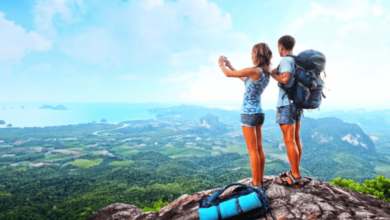
Why is Island Peak the Best 6000m Peak to Climb After Everest Base Camp?
For mountain climbers and adventure freaks, Everest Base Camp is such an achievement. However, for those, who want to explore the mysterious Himalayas and want more, Island Peak (‘Imja Tse’’) is the answer.
Also known as the Imja Tse or as it is popularly known Island Peak, has an elevation of 6189 m (20305 feet) about the sea level. Rising as one of the most beautiful, reachable, and 6000m peaks in Nepal, Island Peak is also known as Mukut Peak.
Be it a newbie EBC climber or an ambitious climber with accompanying interests in climbing skills, Island Peak is an exciting adequate for your Everest Base Camp trip. Island Peak Climb is the most preferred climbing peak after Everest Base Camp because it is technically less demanding and easier.
Thanks to altitude medicine, and many reasonable logistical arrangements that dramatically improve spectacular sceneries. This blog post will take you through why Island Peak is the perfect 6000-meter peak that can be done after the Everest Base Camp covering everything that you need to know about it including its accessibility, challenge, and pleasing sights.
Island Peak: The Ideal 6000m Peak to Conquer After Everest Base Camp
Even after the unforgettable trek to Everest Base Camp, every lover of adventure seems to be looking for something more again. For those willing to take a step further in this incredibly interesting sport, Island Peak or Imja Tse 6189 m high is an ideal target.
Situated in the beautiful Khumbu area, this peak is easy to climb yet adventurous, making it one of the most sought-after peak climbers in Nepal. Island Peak is quite popular for being the first 6000-meter peak that a climber attempts after returning from the Everest Base Camp as it is nearer, manageable to climb, and has the best view of Lhotse, Makalu, and Ama Dablam.
It is also very easy for trekkers to add Island Peak to their Everest Base Camp itinerary as Island Peak helps bridge the gap between Everest Base Camp trek and climbing. Due to the nice level of its technical aspects and highly qualified Sherpas who assist climbers, this peak may be the first in a climber’s attempt in practice.
With incredible views, a satisfying feeling of achievement, and great opportunities for further cultural experiences in the Khumbu region, Island Peak is one of the best options after EBC for active travelers who wish to test themselves more.
1. Accessibility and Proximity to Everest Base Camp
One of the reasons why Island Peak stands out among other 6000-meter-high peaks after Everest Base Camp is that the trek for climbers is very short. The Island Peak is located in the Khumbu region of Nepal near the Chhukung village.
Nearly all the trekkers have already trekked the Everest Base Camp (EBC) classic route which makes it easy to append Island Peak climbing with EBC trek.
For climbers who have already traveled the Base Camp trek and are already acclimatized, including Island Peak is almost recommended as it entails very little traveling and more time for inclusion on your schedule.
Once climbers have enjoyed the beautiful sights surrounding the EBC, it is quite easy for them to move to Chhukung, which is the starting point for preparations for the summit attempt. The climbing adventure and trekking tour itineraries frequently go hand in hand to optimize your stay in the Khumbu region and improve the organization of the activities.
2. Perfect Entry-Level Peak for Aspiring Mountaineers
Island Peak or Imja Tse in many ways is one of the fabulous trekking peaks of Nepal which is also perfect for novice hikers. Consequently, an opportunity to summit a peak that is generally located under the highest multitude of areas that are from 7000 meters to 8000 meters creates a lot of illusions or delusions.
Despite being referred to as a trekking peak measuring only 6189 meters, Island Peak is nonetheless a true peak that involves climbing on snow, off-course glaciers, kite climbing, revising, and using gears such as icy borers and clutches.
This is suitable for those who have trekked the Everest Base Camp and are eager for more challenges and seek better than what they have previously shoulder. Whereout aside from the acclamation around it, Island Peak also doesn’t expect you from the technical climbing to have an extensive background.
If you are healthy, have some basic skills concerning mountains, and are well prepared after the EBC trekking, this climb may be attempted under the guidance of an instructor. A large number of people consider the Island peak as a preparatory level before higher altitudes with better levels of complexity.
3. Stunning Panoramic Views of the Himalayas
The ascent to the top of Island Peak is one of the beautiful trekking climbs that flourished within the Himalayas. On one hand, while climbing the peak images including surrounding peaks such as Lhotse (8516 m), Nupste (7861m), Makalu (8485m), Baruntse (7129m), and Ama Dablam (6812m) will be enjoyed.
The views from the top of the mountain are extraordinary and provide a perfect end to your efforts during this monitoring trip. Island Peak is an island in the sea that is surrounded by the high Himalayan peaks due to the reason it is peeking among the mountains.
The surrounding view of the Khumbu area is simply jaw-dropping and an extra feeling of being alone on top of the highest mountain and gives one the peace and satisfaction of the climb.
4. A True Alpine Experience in the Khumbu Region
Island Peak is a complete alpine experience but with lower hazards than those experienced in the higher peaks of the Himalayas. The ascent requires movement of crevasses, a high climbing phase, and a dramatic ascent to the summit amidst views of some of the legends of mountaineering.
For people coming after the trek to the Everest base camp, this is just the beginning of bringing out the Mountaineers in every individual. Right from step cutting with the use of special gears, using a series of ropes and ladders, Island Peak offers one of the best training grounds for such climbers as they prepare to do more technical climbs in the future.
Every person will have a chance to push the envelope, physically and mentally, but will do so in a more moderate type of activity for beginners which climbing is not an extreme sport.
5. Acclimatization and Safety After Everest Base Camp
Island Peak is a fascinating peak in the Himalayas which can be fairly well managed as long as one is properly equipped. Due to several climbers making it to Island Peak after reaching the EBC, the climbers are already used to high elevations.
It is important because that is one of the major troubles when climbing in the Himalayas. This is especially true for climbers who have rested for a few days in the Everest Area Base Camp above the 5000-meter zone, they do not have difficulty when it becomes time to make their ventures into higher altitudes.
No matter what the situation is, you should always remember that the measures should be taken concerning time while climbing. Climbing higher and respecting the days for adjustment after reaching the top is important for further accomplishment and/or safety.
6. Experienced Sherpa Support and Professional Guides
One of the best qualities about climbing Island Peak is the incredible amount of help that one can get from local Sherpas and professional mountain guides. Sherpa guides in the Khumbu region are very experienced in assisting climbers scale different peaks including Island Peak.
These peaks are invaluable especially when climbing to the summit to guarantee safety and success. As is with most such expeditions, basic climbing gear is provided, and there are training programs and detailed requirements to understand the course, weather, and land.
Since Sherpas are adept at mapping landscapes, you do not have to worry much about the effects of high-altitude climbing in the Himalayas. For those who feel that the challenge might be too huge, the guide’s assistance may help in softening the fear, especially for new climbers.
7. Challenging But Achievable for Most Climbers
Rising to 6189 meters above sea level is a great challenge because the climbers will be required to show some endurance, strength, and determination. The Island peak climb is very successful for most individuals who are fit enough after the EBC trek and have got acclimatized with the altitude with the correct instructions.
Rising to the actual summit involves climbing up a steep ice wall, across a ridge to stand on the highest point. This requires a little technical skill, but this part of the climb can be overcome with the use of fixed ropes and qualified guides. At some point, the summit day tends to become long and quite demanding, but the joy of standing on top of the world is hard to express.
8. Cultural and Spiritual Connection to the Khumbu Region
Completing the Island Peak Trek further intensifies your respect towards the local inhabitants’ culture and religious values as well. It is necessary to traverse the Sherpa settlements, monasteries, stupas, and so forth on the way to and from the peak.
Quite insightful, this region is closely associated with the culture of mountaineering, and hence the Sherpa people worship the mountains with great honor. The reason, or the motivation rather, may be the aspect of the experience located in that desire of culture.
Before heading towards the top, there are places climbers want to go, like the Tengboche Monastery, where they are even blessed and this makes all the difference when trying to make that summit.
Read more; Wallpaper:2qjdtg68ufg= Winter Background
9. Physical and Mental Preparation for Higher Peaks
Mentioning the word “training” whenever Island Peak is concerned is an understatement for this little mound as it is going to be the top of practice before attempting higher peaks in the climbing hierarchy.
The altitude, the area, and the modes will all set you up for the challenges of mountaineering at higher levels. Those climbers who are looking forward to conquering mountains that are taller and steeper than Mera Peak, Lobuche Peak, or the 7000/8000 meters mountains, are best introduced to the world of Himalayan climbing by Island Peak.
All the reasoning, perspectives, and rationale, an approach that deals with sleep deprivation and maintaining focus during tough times, and a deep-seated understanding of the fear of climbing at heights are useful for the expeditions planned.
Climbers who summit Island Peak, come down enriched not with the experience of climbing provided to them but with confidence and knowledge of their bodies and themselves.
10. A Personal Journey and Unforgettable Experience
Trekking to Island Peak involves more than just walking up a mountain with an elevation of 6000 meters above sea level. It is the starting point where one seeks to know one’s boundaries, courage, and passion for the heights.
After all those treks and climbs to be awarded the sight of a peak high in the Himalayas is as rewarding as it gets. The compelling combination of beautiful terrain, physical exertion, and the culture of the Khumbu area makes Island Peak an adventure to be cherished.
As for most climbers, Island Peak is often the most important step in their climbing career and the feeling of achievement coming is great. Be it for fun, beauty, or challenge climbing Island Peak provides everything in plenty.
The Final Wrap Up
Many consider Island Peak as the ideal 6000m mountain to conquer after Mount Everest due to several good reasons. Its ease of access and the moderate level of technicality make it an excellent choice for the Everest Base Camp Trek.
It is genuinely the first step towards conquering mountains, with experienced Sherpa guides ensuring that nothing goes wrong. Island Peak provides an adventure for those who want to push their limits, have spectacular views of the Himalayas, and have amazing experiences.
Whether you want to improve your climbing skills or simply do something more exciting than the Everest Base Camp trek, Island Peak will be suitable for your next Himalayan adventure.




